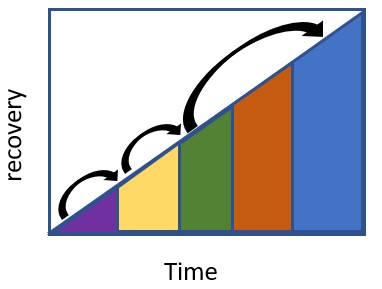Learn about tissue healing time frames and avoid making common mistakes in recovering from injury.
The concept of a quick fix fails to take into account the normal healing time frames of tissues.

There are many therapies and techniques that can relieve pain, … temporarily.
A quick fix assumes you just want to get rid of pain now. But what about in a few weeks’ time when your pain comes back, do you go back to the therapist for another quick fix, … and so repeat the same cycle? Or perhaps you try every different therapy around in the hope they can ‘fix’ you in 1 or 2 sessions … ?
A ‘quick fix’ promotes false hope that recovery is speedy and effortless. The reality is to recover well requires consistent effort over a period of time, to sufficiently address the contributing and causative factors.
Different tissues repair and recover at different rates. What tissues are involved in your problem will give an indication of how long it will take to heal.

Following an acute injury, the body responds with phases of inflammation (to protect and clean up), proliferation (to patch up and regenerate) and remodeling (to mature and refine the rebuilding).

Can you see that a one-off therapy isn’t going to change these healing time frames? To recover well what we need is optimal input that progressively stimulates the tissues over the course of healing. This helps prevent complications and compensatory movement patterns, which can become habit and persist even when the original tissue has repaired, which is often the case with chronic issues.
A common mistake is returning to full activity once pain has gone. But tissue repair does not equal optimal function. And pain free does not equal recovered performance. People make the mistake of dis-continuing rehabilitation once the pain is under control thinking that they are good to go. They might manage day to day task for a while but sooner or later they will do an unaccustomed activity (like helping a friend with brick paving all weekend) or return to sport (high load, high speed, repetition), which the body doesn’t have the capacity for and pain and dysfunction will creep back in. Without building resilience you are setting yourself up for flare-up and recurrence.
Most musculoskeletal issues require a course of treatment to desensitise irritated tissues, correct poor movement habits, build strength and resilience, return to full function and prevent recurrence. So, why would you expect your horse to be ‘cured’ in one session of therapy and continue to exercise and be right for a competition on the weekend? Hmm

An example pathway to recover well based on progressive Physiotherapy input.
Other mistakes are skipping steps in rehabilitation, basically doing too little and then too much.
Advancing too quickly – progressing exercises at a rate tissue healing can’t keep up with.
Insufficient recovery time, failing to allow for the ups and downs of life, stress and lack of sleep can all negatively impact recovery and trigger flare-ups. So be prepared for the road to recovery to have a few bumps and you’ll be able to get back on track again.
Not seeing through a course of rehabilitation is doing you and your horse a dis- service, it wastes time and money with cycles of repeating the first few stages of recovery, rather than reaching your goal of harmonious performance.
A quick fix is fast, but it won’t take you very far.
Recover Well with AB Physiotherapy Services for horses and riders.
Read about my loyalty reward program on the pricing & policies page
Read about when massage is useful in the blog: Massage versus Rehabilitation







Comments